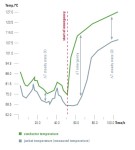Real Time Thermal Rating For Energy Transmission and Distribution Systems
Distributed Temperature Sensing (DTS) Answers for Modern Power Management
IEC 60287/ 60853
Rising demand for electricity is creating the need for utilizing important transmis- sion backbones at their maximum capacity. Enormous benefits can be generated by improving utilization of existing and future installations, and this is where EN.SURE can supply valuable assistance. Based on the real time temperature measurements along the entire cable circuit and the actual electrical current reading EN.SURE
offers the exact dynamic cable rating of the installation, based on the IEC 60287 and
IEC 60853 standards.
The embedded RTTR calculation engine computes the current-carrying capacity (or ampacity) under given conditions of the underground cable installation for the steady state and transient. Cable Operators will greatly appreciate the transient simulation that will allow them to estimate the current that can be safely transferred from another circuit to the monitored installation, due to unusual operating conditions in situations such as emergencies, maintenance, outages, faults, etc. The EN.SURE RTTR engine can be used for emergency ratings from 10 minutes and up to 2000 hours. This covers the entire emergency rating spectrum since typically emergencies last a few hours or days.
Power cable monitoring combined with Real Time Temperature Rating (RTTR) provides valuable data to Operators:
- Steady State Operation – Power cable conductor temperature at the core of the conductor
- Transient Operation – Emergency ratings, transient calculations for Time/ Current/Temperature
Furthermore, the RTTR system can provide continuous and automatic adjustment of calculation parameters such as ambient temperature, thermal resistivity, etc..
Conductor temperature 90 °C/105 °C
Intelligent and Precise Load Management Even During Hot Emergency Events
The EN.SURE emergency rating provides the following information useful for the cable operator under newly given operating conditions:
- Based on a higher load applied for so many hours: What will the cable temperature be at the end of the emergency case? n Given the operating temperature and the applied (over) load, the EN.SURE RTTR solution predicts the temperature of
- the cable in the future.
- Based on a higher load for a given period of time: When will the installation reach its design emergency temperature?
- Given the operating temperature and the applied (over) load, the RTTR gives the time that it will take for the cable to reach a specified emergency temperature.
- Based on initial conditions and a maximum operating tem- perature: What is the maximum current that can be carried by the system?
- Given the operating temperature and a time frame for an over load, the EN.SURE RTTR computes the maximum current that the circuit can carry to reach certain emergency temperature.
Why Adding RTTR to Distributed Temperature Sensing?
Real Time Thermal Rating (RTTR) removes all uncertainty left by the DTS and is an important component of the EN.SURE system. The DTS measures the real time temperature at the sheath or jacket of a cable. The sheath temperature gives
a good idea of the temperature of conductor, but unless an accurate model for the conductor is provided there will be some uncertainty left.
The uncertainty is small during steady state operation, but it could be (very) large during an emergency situation. The following figure illustrates the temperature of the jacket and conductor during an emergency situation. One can appreciate that while the temperature difference (∆T) between the jacket and the conductor can be small in steady state (1).
However, moments after the onset of an emergency situation the temperature difference could be very large. The reason is that cable insulation has a large inertia and therefore the heating of the conductor can only be detected at the jacket several minutes (to hours) later. Additionally, the temperature difference changes with the loading level. The temperature difference is larger for larger loading levels.



